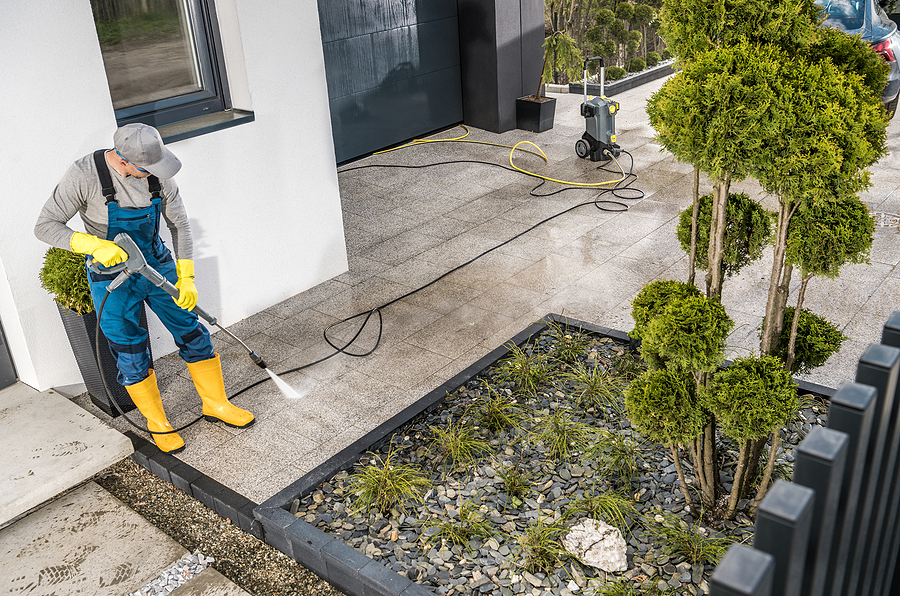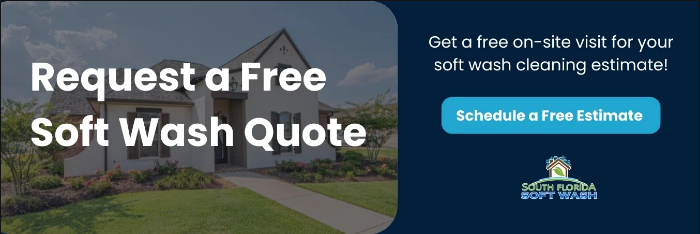How Often Should You Clean Your Roof, Driveway, or Siding?

- April 28 2025
- South Florida Soft Wash
Your home’s exterior endures constant exposure to the elements—sun, rain, wind, and everything in between. Over time, this wear and tear allows dirt, algae, mold, and mildew to accumulate on surfaces like your roof, driveway, and siding. Not only can this buildup diminish your home’s curb appeal, but it may also lead to costly, long-term damage.
So, how often should you clean these areas? The answer depends on several factors, including your local climate, nearby environment, and the materials used in your home’s construction. Among the various cleaning options, soft washing stands out as one of the safest and most effective methods—particularly in Florida’s unique climate. In this guide, we’ll explore the recommended cleaning schedule for your home’s key surfaces and share tips on recognizing when it’s time to call in the professionals.
How Frequently Should You Clean Your Roof, Driveway, and Siding
Roof
General Recommendation: Every 1–3 years
Your roof plays a critical role in protecting your home from the elements, and regular cleaning is essential to maintain its structural integrity and curb appeal. Neglecting roof maintenance can lead to the buildup of grime, algae, and moss, which may eventually cause long-term damage or premature aging of your roof. Cleaning your roof every 1–3 years is a good general rule, but several factors may influence how often you should schedule a cleaning.
Frequency Factors:
- Tree Coverage and Shade: If your home is surrounded by trees with overhanging branches, your roof is likely to collect leaves, twigs, and other debris. This debris can trap moisture, creating the perfect environment for moss, mold, and algae to thrive. Over time, these growths can compromise the integrity of your shingles and lead to costly repairs. Trimming back trees and scheduling regular roof cleanings can help prevent these issues.
- Humidity Levels and Rainfall: Homes in humid climates or areas with frequent rainfall—such as many cities in Florida—are more prone to algae streaks and black stains on their roofs. These unsightly blemishes not only affect your home’s appearance but can also degrade the materials over time. If you live in a climate like this, you may need to clean your roof more frequently to prevent the buildup of algae and moisture-related damage.
- Visible Staining or Algae Growth: If you notice discoloration, streaks, or any type of staining on your roof, it’s a clear sign that it’s time for a cleaning. Ignoring these visual cues can lead to deeper issues, as the growth of algae or moss can spread and take root, causing more damage and reducing the lifespan of your roof.
Warning Signs to Watch For:
- Black streaks or stains caused by algae: These streaks are often the result of Gloeocapsa magma, a type of algae that thrives in warm, moist environments. Not only is this algae unattractive, but its presence can also signal that other parts of your roof may be at risk of damage.
-
- Moss growth on shingles: Moss can grow quickly in shaded, damp areas of your roof. If left untreated, moss can wedge under shingles, exposing your roof to water damage and rot. Removing moss as soon as it appears is crucial to prevent structural issues.
- Moss growth on shingles: Moss can grow quickly in shaded, damp areas of your roof. If left untreated, moss can wedge under shingles, exposing your roof to water damage and rot. Removing moss as soon as it appears is crucial to prevent structural issues.
-
- Black streaks or stains caused by algae: These streaks are often the result of Gloeocapsa magma, a type of algae that thrives in warm, moist environments. Not only is this algae unattractive, but its presence can also signal that other parts of your roof may be at risk of damage.
- Humidity Levels and Rainfall: Homes in humid climates or areas with frequent rainfall—such as many cities in Florida—are more prone to algae streaks and black stains on their roofs. These unsightly blemishes not only affect your home’s appearance but can also degrade the materials over time. If you live in a climate like this, you may need to clean your roof more frequently to prevent the buildup of algae and moisture-related damage.
-
-
-
- Shingle damage from prolonged grime accumulation: A dirty roof doesn’t just look bad—it can cause significant damage to your shingles over time. Grime, algae, and moss can weaken shingles, making them brittle and more likely to break or dislodge. This exposes your roof to water leaks and other structural challenges.
The Best Way to Keep Your Roof Clean:
Soft washing is the most effective and safest method for cleaning roofs. Unlike high-pressure washing, which can damage shingles by stripping away granules or causing cracks, soft washing uses a low-pressure cleaning process combined with specially formulated cleaning solutions. These solutions penetrate deeply to remove algae, moss, and grime at their roots, ensuring a thorough clean without harming your roof. By using soft washing, you can extend the lifespan of your roof, maintain its appearance, and protect your home from potential damage caused by unwanted growths.
- Shingle damage from prolonged grime accumulation: A dirty roof doesn’t just look bad—it can cause significant damage to your shingles over time. Grime, algae, and moss can weaken shingles, making them brittle and more likely to break or dislodge. This exposes your roof to water leaks and other structural challenges.
-
-
Driveway
General Recommendation: Every 1–2 years
Your driveway faces constant wear and tear, from the weight of vehicles to oil stains, dirt, and exposure to the elements. Regular cleaning is essential not only for maintaining a polished appearance but also for preventing long-term damage such as cracks, discoloration, and surface degradation.
Frequency Factors:
The ideal cleaning frequency depends on several factors that influence the condition of your driveway:
-
-
-
-
- Tire Marks and Oil Stains: If your driveway sees heavy traffic, tire marks and oil stains are inevitable. Over time, these marks can become deeply embedded in the surface, making them harder to remove. Regular cleaning ensures that stains don’t accumulate and degrade the surface, keeping your driveway looking fresh and well-maintained.
- Tire Marks and Oil Stains: If your driveway sees heavy traffic, tire marks and oil stains are inevitable. Over time, these marks can become deeply embedded in the surface, making them harder to remove. Regular cleaning ensures that stains don’t accumulate and degrade the surface, keeping your driveway looking fresh and well-maintained.
-
-
-
-
-
-
- Mold Growth: Moisture and heat create the perfect environment for mold, mildew, and algae to thrive on your driveway. These growths don’t just look unsightly—they can also make the surface slippery and hazardous, especially when wet. Cleaning your driveway regularly helps eliminate mold and prevent it from spreading.
- Nearby Trees: If your driveway is surrounded by trees, you’re likely dealing with fallen leaves, sap, and occasional bird droppings. Leaves left to pile up can stain your driveway, while tree sap can create sticky patches that attract dirt and debris. Frequent cleaning is especially important in the fall, when leaf shedding is at its peak.
- Mold Growth: Moisture and heat create the perfect environment for mold, mildew, and algae to thrive on your driveway. These growths don’t just look unsightly—they can also make the surface slippery and hazardous, especially when wet. Cleaning your driveway regularly helps eliminate mold and prevent it from spreading.
-
-
Why Cleaning Matters:
A spotless driveway doesn’t just improve the look of your property—it protects the surface from further damage. Soft washing is the best cleaning method, as it gently removes stains and buildup without causing damage to the surface. By maintaining a clean driveway, you can extend its lifespan, reduce repair costs, and keep it safe and visually appealing for years to come.
Siding
General Recommendation: Once a Year
Your roof plays a critical role in protecting your home from the elements, and regular cleaning is essential to maintain its structural integrity and curb appeal. Neglecting roof maintenance can lead to the buildup of grime, algae, and moss, which may eventually cause long-term damage or premature aging of your roof. Cleaning your roof every 1–3 years is a good general rule, but several factors may influence how often you should schedule a cleaning.
Warning Signs to Watch For:
-
-
-
- Green Algae or Black Mold: These growths not only make your home look unkempt but can also cause structural damage if left untreated. Mold, in particular, can spread quickly and impact the health of your household.
- Discoloration and Fading: Over time, dirt and UV rays can dull the appearance of your siding, making it look worn or aged. Regular cleaning can restore its vibrant color and shine.
- Musty Odors: Trapped dirt and moisture can lead to unpleasant smells, signaling the presence of mold or mildew beneath the surface. Cleaning can eliminate these odors and reduce the risk of further damage.
Clean and Preserve Your Siding:
Soft washing is the ultimate way to clean your siding, offering a safe and highly effective solution. This method not only preserves the integrity of your siding but also extends its lifespan by preventing wear and tear caused by high-pressure systems.
- Green Algae or Black Mold: These growths not only make your home look unkempt but can also cause structural damage if left untreated. Mold, in particular, can spread quickly and impact the health of your household.
-
-
How Climate and Location Impact Cleaning Schedules
Your local environment greatly impacts how often you need to clean your surfaces. For example, homes in Florida face unique challenges due to its subtropical climate.
Why Florida Homes Need More Frequent Cleaning:
- High Humidity encourages mold, mildew, and algae to grow faster.
- Hurricanes and Rainy Seasons deposit dirt and debris on your surfaces.
- Coastal Climates often see salt buildup, leading to corrosion on siding and roofs.
- Pollen blankets homes, especially in spring, creating visible yellow-green layers.
Tips for Southwest Florida Homeowners:
- Clean your home at least annually, regardless of visible dirt.
- After the rainy season (fall) and during pollen season (spring) are optimal times for a refresh.
- If you’re near the coast, consider an extra cleaning to remove salt damage.
Stay Ahead with Routine Cleaning
Whether it’s a sparkling driveway, algae-free siding, or a streak-free roof, regular soft washing ensures your home stays in peak condition. By developing a maintenance schedule based on your home’s unique needs, you can avoid costly repairs down the road.
Don’t wait until grime gets the upper hand. Take action today and keep your home looking its best. Schedule your free consultation with South Florida Soft Wash and give your property the care it deserves.


